


Crux Australis Herald
Baron Uberto Renaldi [mka Nigel Castle]
GPO Box 2719, Adelaide SA 5001, Australia
phone: (08) 8336 6791 or intl +61 8 8336 6791
 |
Crux Australis Herald
|
"The CAMeL" Unto the College of Heralds of the Principality of Lochac, and all others who may read this missive, from Baron Uberto Renaldi, Crux Australis Herald, greetings! In this issue...
Reports | Heraldry at First Coronation
Reminder - change to resubmission policy |Reminder - change to heraldic ranks and titles
On brown as a tincture | Roll of Arms competition | Roster changes
Important addresses | Subscriptions and Resources | Submission requirements
Meeting schedule | Recent submissions | News of previous submissions | Closing words
June 2002 (Anno Societatis XXXVII)
Goodbye, cruel world! There are a lot of people whom I must thank for their assistance: Mistress Aislinn de Valence for handing me an office in such good shape; Giles Leabrook for taking the office away from me; Gruffydd ap Cynan, Massaria da Cortona, Wakeline de Foxley and William de Blacwode for being regular attendees at my meetings; Catherine Parry, Ludwig von Regensburg and They Might Be Giants for helping me stay (almost) sane; Claire Marie Alderton, Declan of Drogheda, Karl Faustus von Aachen, Sabine du Bourbonnais and William Castille for asking lots of sensible questions; the commenting heralds of the College of Arms for putting up with my flaky Letters of Intent; Master Gereint Scholar for being the best teacher and inspiration that any budding herald could wish for; and finally - everyone else in the College of Heralds of the Kingdom of the West who have done something to further heraldry in Lochac. Without all of you, my job would have been impossible (and this paragraph much shorter).
In my first CAMeL, back in October 1999, I expressed the desire to "improve the quality of heraldry and the status of heralds...in Lochac". If this job has taught me anything, it is that one should reach always for the stars whilst being content to keep one's feet dry. And with that dreadful metaphor I bid you farewell...
Your servant,
Baron Uberto Renaldi,

Crux Australis Herald
Reports were due by 11th June 2002. I shall leave it to Giles to devise unique and subtle ways to punish those who have failed to report.
A reminder that Giles and I will be expecting all rostered heralds attending Coronation to assist if they are able to do so. Karl Faustus will be coordinating the rosters for duty and field heraldry, and I will be overseeing the courts.
For those who are interested: I will be formally handing the office over to Giles at the Ball being held on the Friday night of the weekend of Coronation. I would love to see lots of heralds there to bear witness.
Reminder - change to resubmission policy
As of July's meeting, returned submissions that have not been resubmitted within 3 years of the most recent date of return are no longer free.
Reminder - change to heraldic ranks and titles
As of First Coronation, the system used for heraldic ranks and titles is changing.
Some examples:
If you are currently the Acting Cordon Rouge Pursuivant with a personal rank of Pursuivant Extraordinary, after Coronation you would be rostered as Cordon Rouge Pursuivant with a personal rank of Pursuivant.
If you are currently Bombard Pursuivant with a personal rank of Pursuivant, after Coronation you would be rostered as Bombard Herald with a personal rank of Herald.
If you are currently Canon Pursuivant with a personal rank of Pursuivant Extraordinary, after Coronation you would still be rostered as Canon Pursuivant but with a personal rank of Pursuivant.
If you are currently the Acting PE for the College of Saint Christina with no personal rank, after Coronation you would be the Acting Pursuivant for the College and still have no personal rank.
If you are currently a Pursuivant At Large, your listing will change to Herald Extraordinary. Current Pursuivant Extraordinaries At Large will become Pursuivants Extraordinary.
Confused yet? I'm sure that with time it will all make sense.
Wreath Queen of Arms (Laurel's deputy for armory) has been collecting opinions over the past few months on the use of brown as a tincture, the result of which is that the College of Arms is re-affirming the precedent from the Cover Letter for the October 1995 LoAR:
PRECEDENT: Henceforward, and more in line with period heraldic practice, animals which are normally brown may be registered simply as an {X} proper (e. g., boar proper, hare proper). Animals which are frequently found as brown but also commonly appear in other tinctures in the natural world may be registered as a brown {X} proper (e. g., brown hound proper, brown horse proper).
This precedent does not, however, loosen the ban on "Linnaean proper" (Cover Letter, May 13, 1991); proper tinctures for flora and fauna which require the Linnaean genus and species to know how to color them. For example, a falcon proper will be considered to be all brown, not brown head, wings and back, buff breast with darker spots, and a tail striped with black; a hare proper will be considered to be all brown, not brown with white underbelly and tail and pink ears. This also appears to be more in keeping with period heraldic practice.
The deadline for entries in the Roll of Arms competition first announced back in February 2000 was Rowany Festival. By then I had received but three entries, including the original one from Aneala that prompted the competition in the first place. Here are the details of each entry:
Aneala: a black & white "colouring book", printed from computer onto ordinary A4 paper. A complete gentry list of the Barony is followed by details of each gentle (3 per page) showing their name, arms (emblazon and blazon) and awards received. The barony's arms in full achievement grace the cover. An excellent way of teaching people about heraldic tinctures whilst familiarising them with the nobility of the group.
Mordenvale/Saint Crispin: a roll of arms for the Shire of Mordenvale, on A3 sheets. The "olde-world" text and the shields are computer generated, but the emblazons themselves have been drawn and coloured by hand. Six gentles are listed on each page, with the listing in order of precedence (i.e. royal peers first).
Saint Florian-de-la-rivière: a flag/banner with the arms and symbols of the barony on one side and arms of it's armigers on the other. As I saw this only briefly at Festival, I am relying on memory here. I do recall that it looked very impressive, but exact details escape me.
Due to the small number of entries, I have decided not to announce a winner. However, these three entries alone show that there is a lot of talent in Lochac, and that good results can be the outcome when it is applied. I am disappointed that more entries were not submitted, but I also realise that the lead-up to kingdom has increased the workload of many groups and made the pursuit of other projects less important.
It is my hope that Giles will continue to encourage the research and production of "rolls of arms" and other period means of heraldic display. For my part, I thank those of Aneala, Mordenvale and Saint Florian who took up the challenge I offered them, and apologise that I can offer them no reward other than my thanks.
Karl Faustus von Aachen, recently forced to step down as Acting Cinquefoil due to his move to Politarchopolis, has agreed to take the equivalent office in his new Barony. He has thus been rostered as Acting Cordon Rouge Pursuivant.
He replaces Snorri Bló{dh}drekkr ór {dh}inslundi, who remains on the roster as a Pursuivant Extraordinary At Large.
The Shire of Bordescros has a new herald: Gabriel Kalothetos, who will be rostered as the Acting Pursuivant Extraordinary for the group until he fulfils the requirements of a personal rank within the college.
The College of Saint Crispin also has a new herald: Rurik Grunfrithson has been rostered as the Acting Pursuivant Extraordinary for that group.
Griffin Reid of Willoughby Vale has scored an excellent 97% in the PE test and has been rostered as a Pursuivant Extraordinary At Large.
Crux Australis Herald (until 6 July): Uberto Renaldi [Nigel Castle] GPO Box 2719, Adelaide SA 5001. Ph (08) 8336 6791. Email herald@sca.org.au
Crux Australis Principal Herald (from 6 July): Giles Leabrook [Braddon Giles] 4A Etonville Parade, Croydon NSW 2132. Email herald@sca.org.au
Hund Herald (West Kingdom external commentary) and Bombard Pursuivant (Ceremonies deputy): Thorfinn Hrolfsson [Steven Roylance] 1592 Malvern Road, Glen Iris VIC 3146. Email roylance@corplink.com.au
Canon Pursuivant (Precedence and Gentry list): Morag Freyser [Helen Brinsmead] PO Box 455, Woden ACT 2606. Email canon@sca.org.au
Mortar Pursuivant (Education and Training): Massaria da Cortona [Melanie Johnston-Hollitt]. Email: massaria@hotmail.com
Rocket Pursuivant (New PE test): Aislinn de Valence [Megan Dansie] PO Box 526, Unley SA 5061. Email aislinn@merlin.net.au
Baryl Pursuivant (External commentary): VACANT- PLEASE APPLY
Subscriptions and Resources
The CAMeL is available from Crux Australis at $20 per year. Make cheques payable to "SCA Inc. College of Heralds".
Laurel's Letters of Acceptance and Return are available from the SCA College of Arms. Send a cheque for $US25 made out to "SCA Inc. - College of Arms" to Bruce R. Nevins, 2527 E. 3rd Street, Tucson AZ, 85716-4114, USA. As usual, everything of relevance to Lochac will be published in The CAMeL.
The Armorial and Ordinary, as well as updates to them, are available from SCA Inc. - Free Trumpet Press West. Their address is '1613 N. School St., Normal IL 61761-1240, USA'. They also sell the "Heraldic Pictorial Dictionary for the SCA", proceedings of Known World Heraldic Symposia and Compilations of Precedents by past Laurel Sovereigns of Arms. Contact me or visit their web site for more details.
I also recommend that groups acquire some name resources, in particular P.H. Reaney & R.M. Wilson's "A Dictionary of English Surnames" and E.G. Withycombe's "The Oxford Dictionary of English Christian Names". The latter is currently out of print, so if you spot it at a second-hand book sale, buy it!
Useful or interesting links:
The Blazons mailing list, the email list for Lochac's heralds - www.sca.org.au/mailman/listinfo/blazons.
The SCA Heraldry web page - www.sca.org/heraldry including the Laurel home page and on-line armorial and ordinary search.
The Academy of Saint Gabriel (lots of good articles on medieval names) - www.s-gabriel.org
West Kingdom Heralds' Handbook - heralds.westkingdom.org
Free Trumpet Press West (SCA heraldic publications) - www.sca.org/heraldry/ftpw.
Parker's Glossary of Heraldry - http://www04.u-page.so-net.ne.jp/ta2/saitou/ie401
Cost: $20 per new submission (name, device or badge). Note: a new name and device costs a total of $40. No cost for resubmissions or branch submissions. Make cheques or money orders payable to "SCA Inc. College of Heralds". Do not send cash through the post!
Copies required:
Please include ALL necessary documentation to support each submission. It is the responsibility of the submittor to present their submission in a way that makes registration easy. Name documentation should be as accurate as possible: remember to include photocopies of the title page as well as the relevent page(s) of any source used.
Giles’ first meeting will be starting at 2pm on Sunday 28th July 2002 at 4A Etonville Parade, Croydon NSW. Please call him beforehand if you intend to bring submissions for processing. His following meeting will probably be on Sunday the 25th August.
Note that due to the delay between my final meeting and Giles’ first, no submissions will be sent to Laurel in July.
Present at the Crux Australis Submissions Meeting held on Sunday 16th June 2002 at 36 Rosella Street, Payneham SA were: Uberto Renaldi, Crux Australis Herald; Giles Leabrook, Crux Australis Designate; William Forester de Blacwode, Pursuivant At Large; Wakeline de Foxley, Pursuivant Extraordinary At Large; and visitors Cassandra, Viscountess Lucrezia Lorenz, Makkuro Hana, Sean McCarrum and Tomas del Valle de Bravo.
My final meeting turned out to be my largest in terms of submissions, with a total of 24 items processed. Even if there hadn't been a party planned to follow, I would still have needed a stiff drink afterwards!
The following submissions were FORWARDED to the College of Arms in March 2002 for registration:
New Name (see RETURNS for Device)
The submitter desires a masculine 12th-14th century Byzantine name, cares most about the language/culture and will accept major changes.
Gabriel: The Laurel web pages on Byzantine names shows this as a masculine given name dated to 1348.
Kalothetos: The Laurel web pages on Byzantine names shows this as a byname dated to 1357.
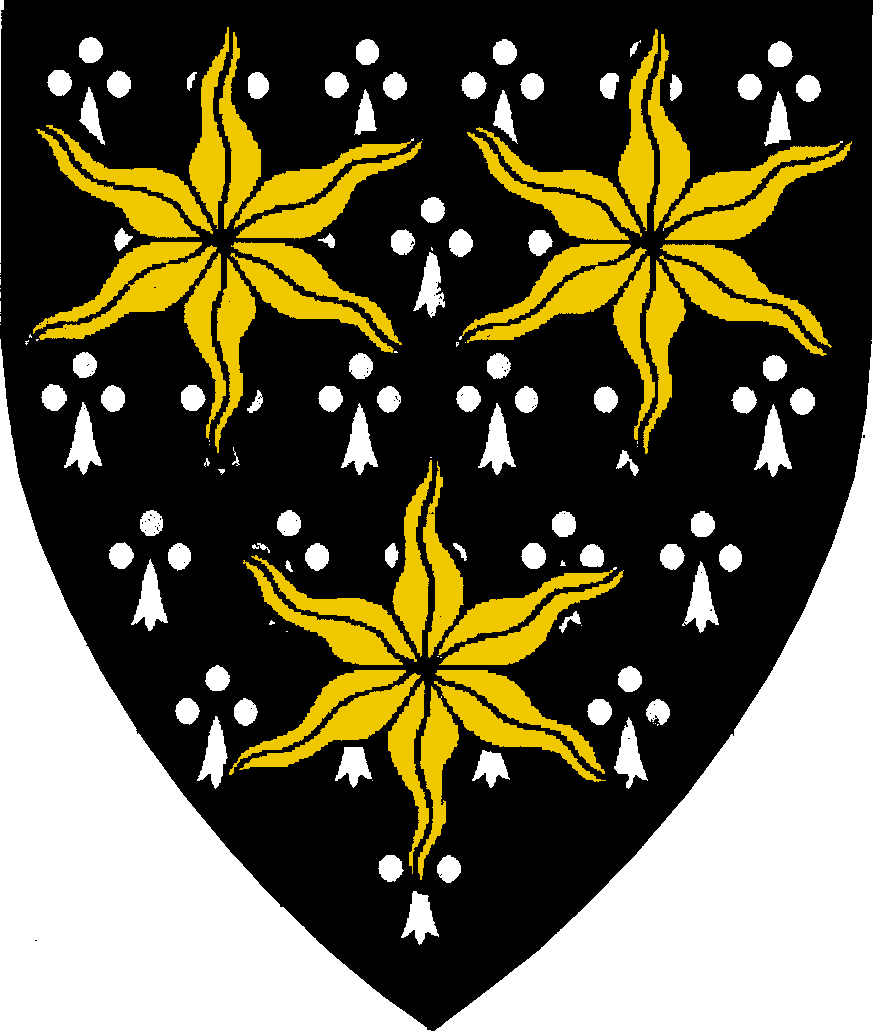
New Name and Device
Counter-ermine, three estoiles Or.
The submitter desires a masculine "late Renaissance" Italian name, cares about the sound and the language/culture, and will accept major changes.
Giovanni: This is listed as the most frequent Florentine masculine given name in the 'Online Catasto of 1427', summarised in 'Italian Names from Florance' [sic].
Basilio: This is listed as a patronymic by Scott & Mittleman (aka Arval Benicoeur & Talan Gwynek) in 'Fourteenth Century Venetian Personal Names'.
de Castronovo: Brian Scott (aka Talan Gwynek) gives this locative in '15th Century Italian Men's Names', and also shows evidence of names of the from <given name> <patronymic> <locative>.
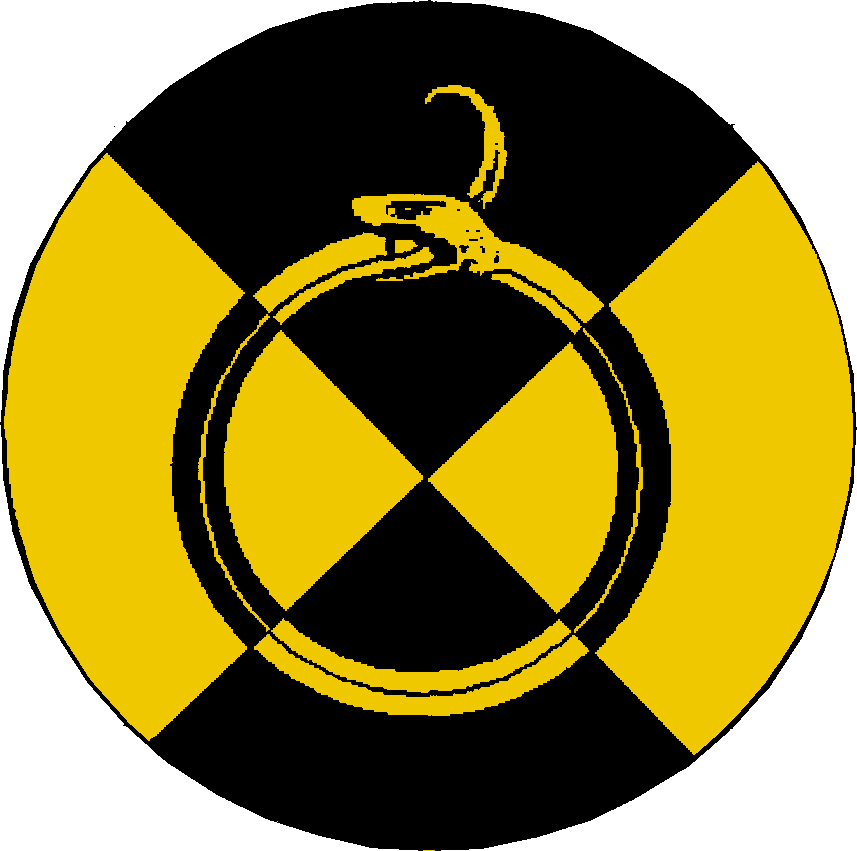
New Badge
Per saltire sable and Or, a serpent involved in annulo counterchanged.
Mini-rant: Please note that the little marks on the edges of the circle on the badge submission forms are there for a purpose - to enable you to draw lines that pass through the centre of the circle and divide the field into parts of equal sizes.
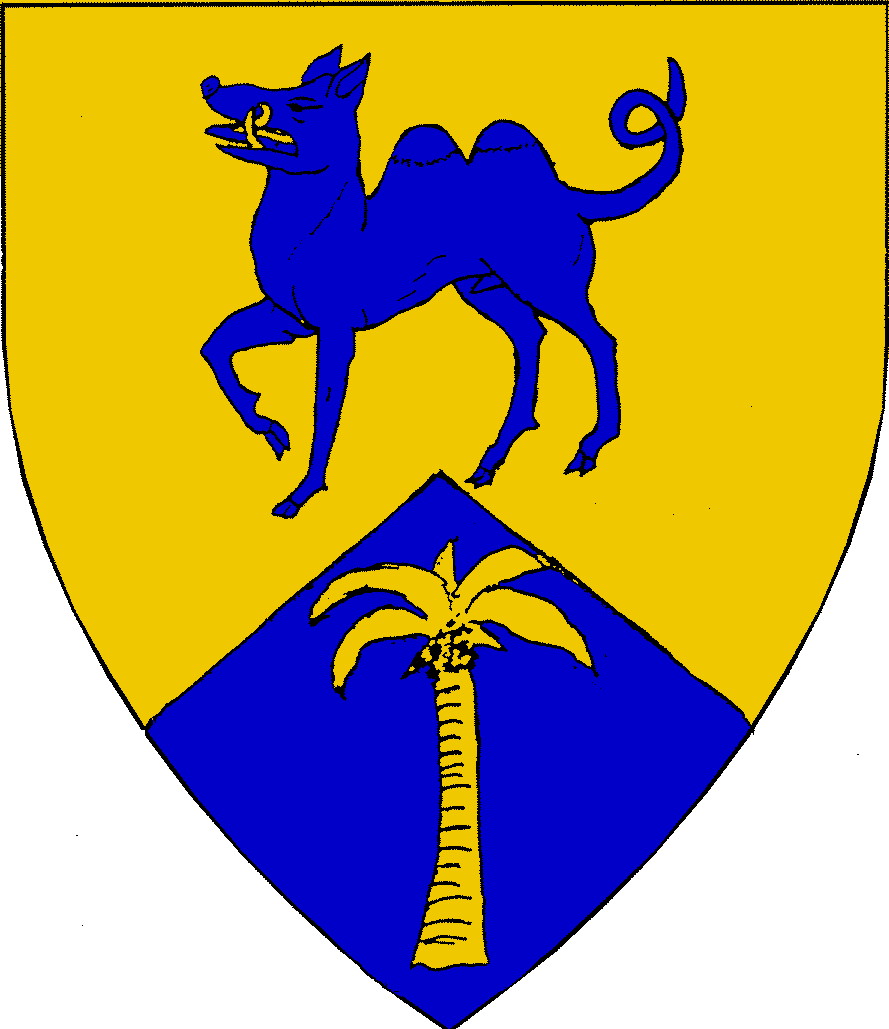
Device Resubmission to Crux
Per chevron Or and azure, an ypotryll passant and a palm tree counterchanged
The name was registered in December 2001. His previous device submission, identical to this one, was returned by Vesper back in July 1996 along with the name he originally submitted at that time.
There was nothing wrong with the device back then (it was the name that had problems), and there appears nothing wrong with it now.
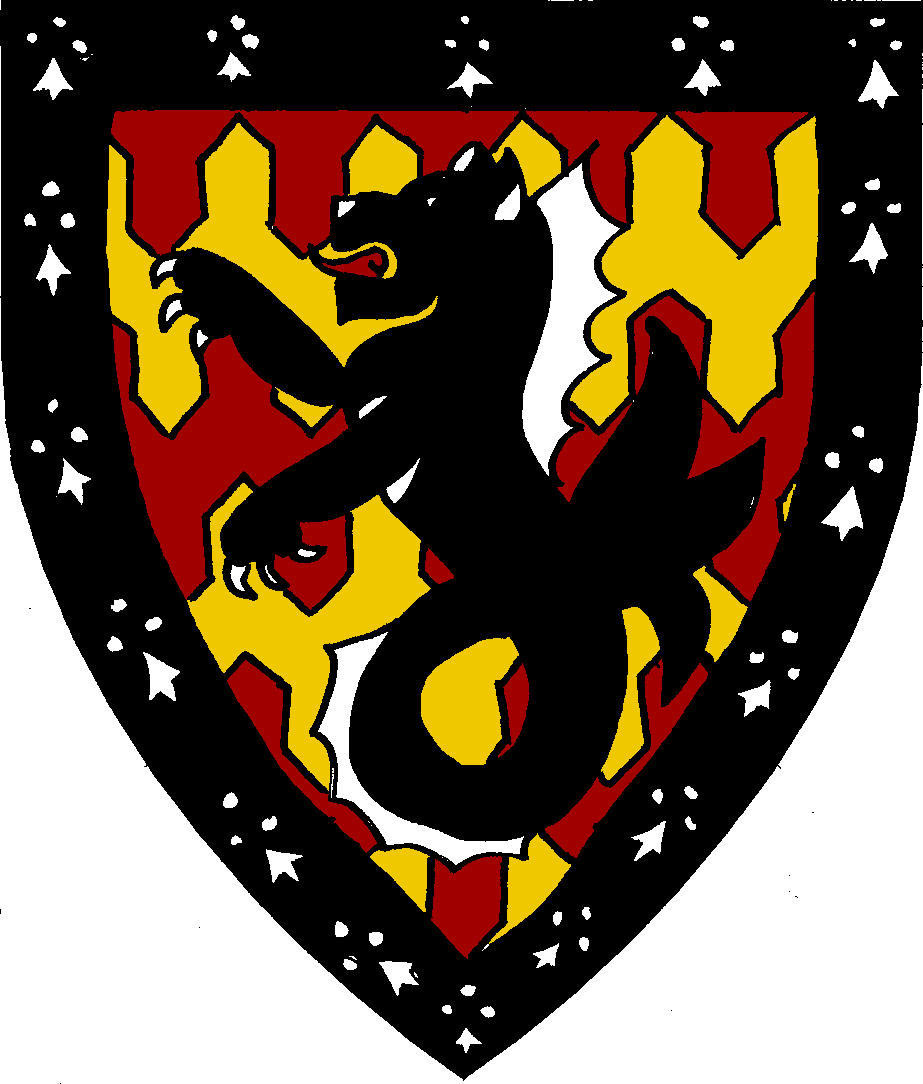
New Name and Device
Vairy-en-point gules and Or, a seawolf erect sable and a bordure counter-ermine.
The submitter will not accept any changes to the name except to change 'Æt' to 'æt' if necessary.
Hrothgar: Withycombe (3rd ed., s.n. Roger) states that this is an Old English name. In the poem Beowulf (line 61) Hro{dh}gar is the name of a Danish king.
Gytingbroc: Ekwall (4th ed., s.n. Guiting) dates the spelling of this placename to 780.
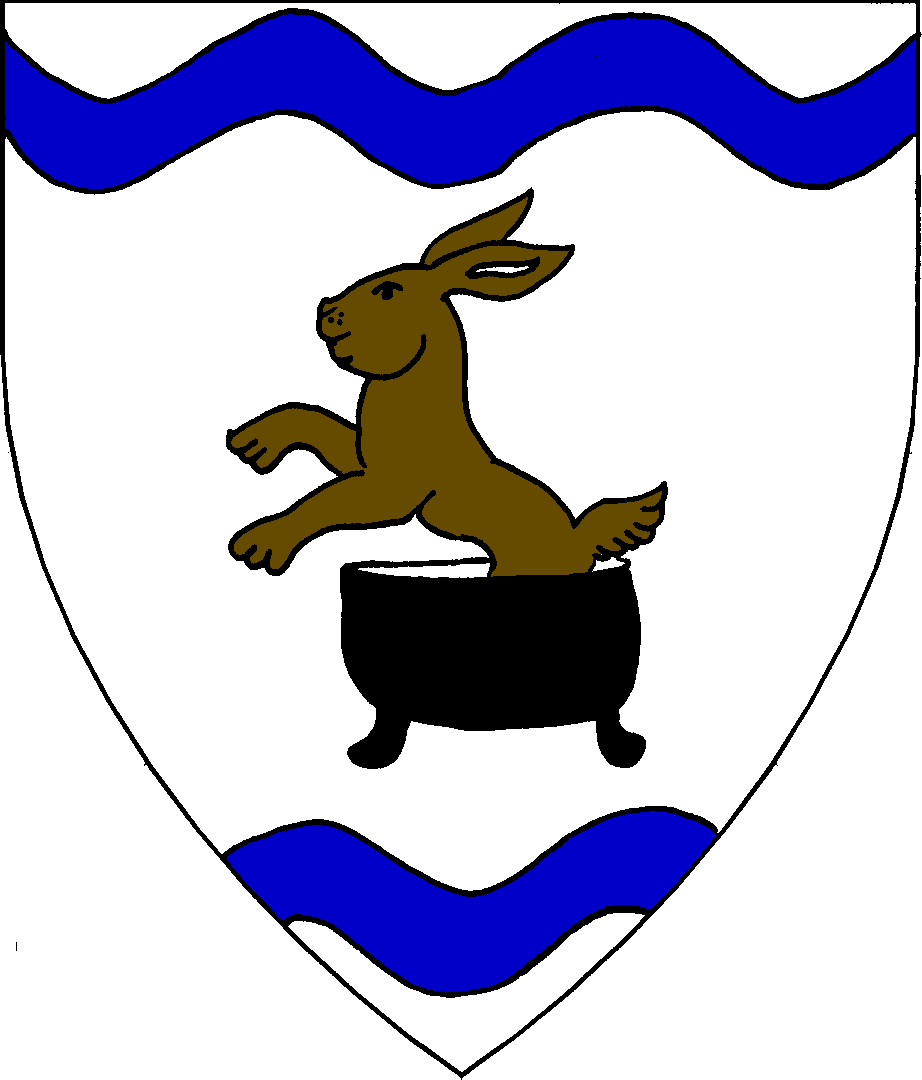
New Name and Device
Argent, a brown hare proper issuant from a cooking pot sable between two bars wavy azure.
The submitter is aware that all the elements of the name are the modern spellings, but will not accept any changes.
Judith: header spelling in Withycombe (3rd ed.), who states that a Judith was the wife of Æthelwulf, King of Wessex (died 878). Judith is also the submitter's legal given name.
Fletcher: header spelling in Reaney & Wilson (2nd ed.), who date Flecher to 1203.
Wellow: Ekwall (4th ed.) has five entries with this as the header spelling.
There was some discussion at the meeting about the bars wavy being so close to the extremities of the field, but it was agreed that it would be difficult to perceive them as anything else (e.g. a chief and base, both wavy and per fess wavy).
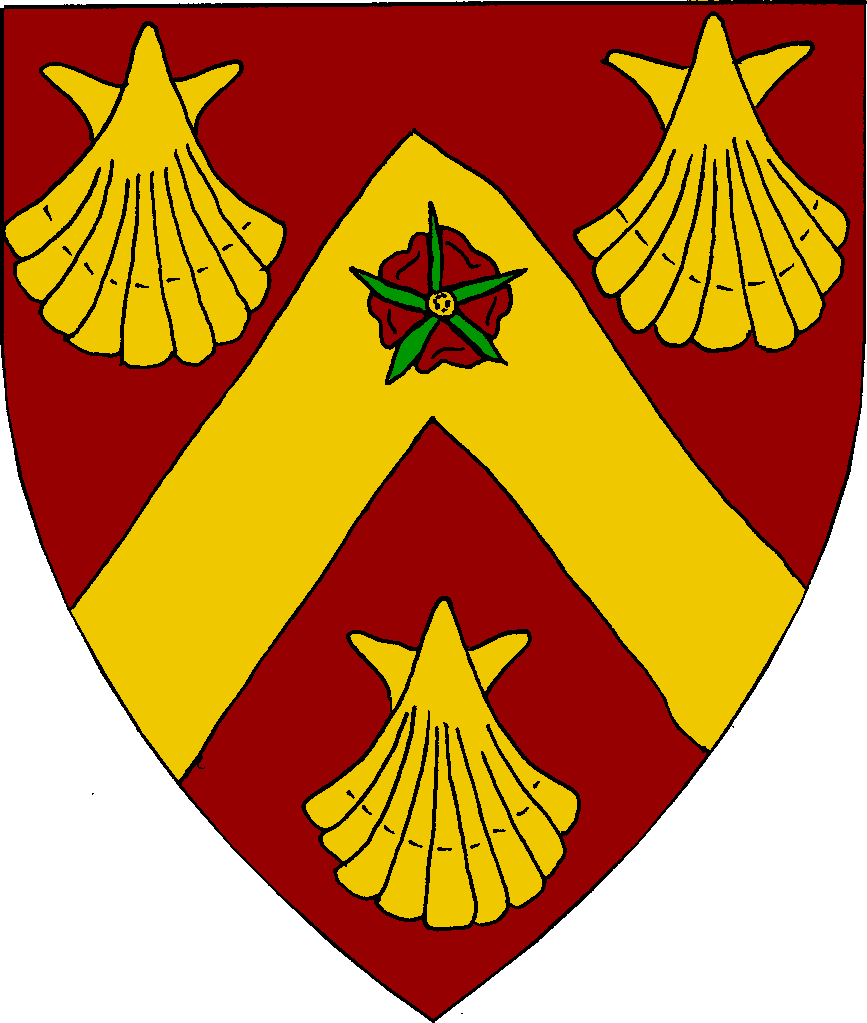
New Name and Device
Gules, on a chevron between three escallops Or a rose proper.
The submitter desires a feminine 16th century French name that means 'Lisette the Vixen' and will accept minor changes only.
Lisette: Brian M. Scott (aka Talan Gwynek) in 'Late Period Feminine Names from the South of France' dates this forename to 1528.
la Mandetta: Scott (ibid) has this byname dated to 1521 as a nickname meaning 'vixen'.
New Heraldic Title
Although we've been using this for a few years now as Crux's deputy for ceremonies, it's never actually been registered. (oops!)
The Oxford English Dictionary (2nd ed., under bombard) gives as the meanings of this word "the earliest kind of cannon" (first citation c.1430), "a leather jug or bottle for liquor" (1596) and "a deep-toned wooden musical instrument of the bassoon family" (1393). Bombarde appears to be the commonest pre-1600 spelling.
New Name (see PENDS for Device
The submitter will not accept any changes.
Seán: Patrick Woulfe in 'Sloinnte Gaedheal is Gall: Irish Names and Surnames' (page 200) says that this was "one of the most common names among the early Anglo-Norman settlers in Ireland". Corráin and Maguire in 'Gaelic Personal Names' (s.n. Seaan: Seán) also say pretty much the same thing.
le Bastard: Reaney and Wilson (2nd ed., s.n. Bastard) have 'William le Bastard' dated to 1201.
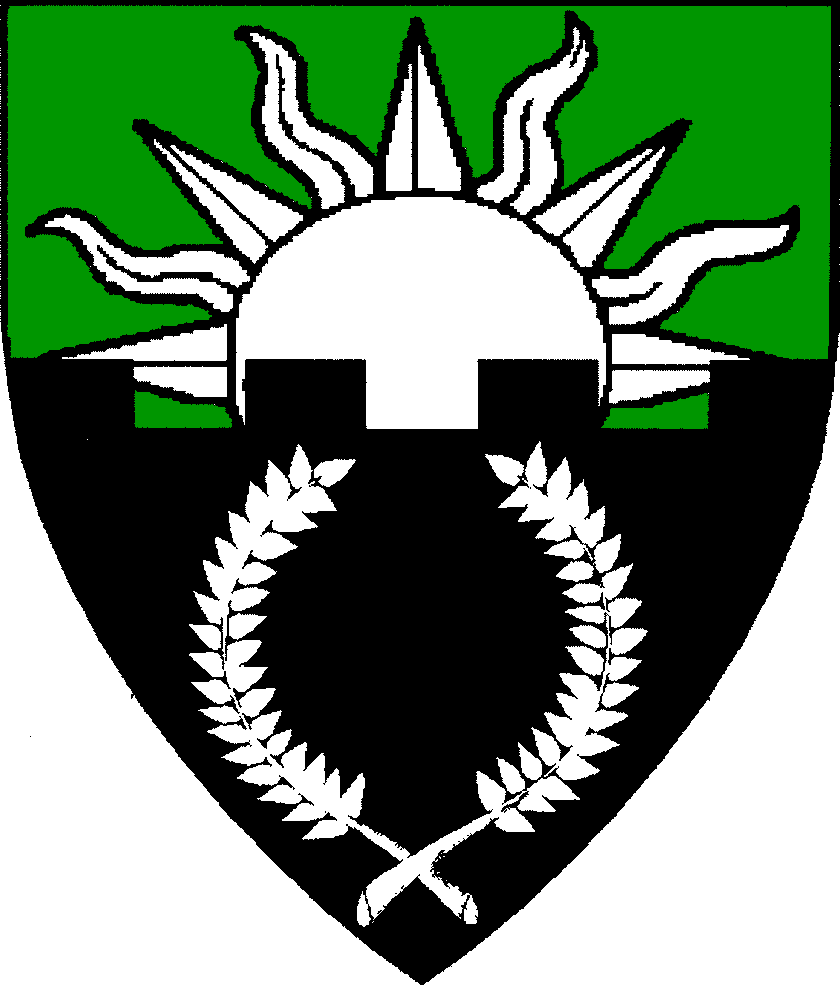
Appeal of return of Branch Name and Resubmission of Device
Per fess embattled vert and sable, a demi-sun issuant from the line of division and a laurel wreath argent.
The group care most about the sound of the name, and will accept major changes.
A.D. Mills in 'A Dictionary of English Place-Names' (s.n. Stow, Stowe) lists Stowe on the Oldedated to 1574. The modern spelling of this town in Gloucestershire, England is Stow on the Wold.
Ekwall (4th ed) shows both of the Old English words stow and wald used as first and second elements in placenames respectively. The literal meaning of the name is 'an inhabitated place in a woodland'.
This submission is an appeal to Laurel (without support of the Lochac College of Heralds) of my previous return of the Branch Name in March 2002, where it was returned under III.A.5 of the Administrative Handbook for conflicting with the name of a significant geographical location outside the Society. It is the belief of the Lochac CoH that the real Stow on the Wold is significant due to it being the site of the last armed conflict of the English Civil War in 1646, and for being a popular tourist destination. A search for the name in the Google WWW search engine returns approximately 12000 sites that feature the name.
The populace of the Canton do not believe that it is any more significant a tourist destination than most English towns, nor that the battle in 1646, although historically interesting, was significant enough that the town's name should be protected. As all appeals must be forwarded on to the level up, this name has been inlcuded on this month's Letter of Intent to the College of Arms.
The Canton also provided another name, Airesborough, which they wanted submitted along with their appeal in case the appeal is unsuccessful. Unfortunately, this cannot be done as items on a Letter of Intent cannot be provisional on another item on the same letter not being registered (that is, widely differing alternativees are not considered at Laurel level).
After all, the items on a Letter of Intent are ones that we intend to have registered, not ones that might be registered if something else isn't. To do otherwise would cause enormous logistical problems at the Laurel level, and they are quite busy enough as it is.
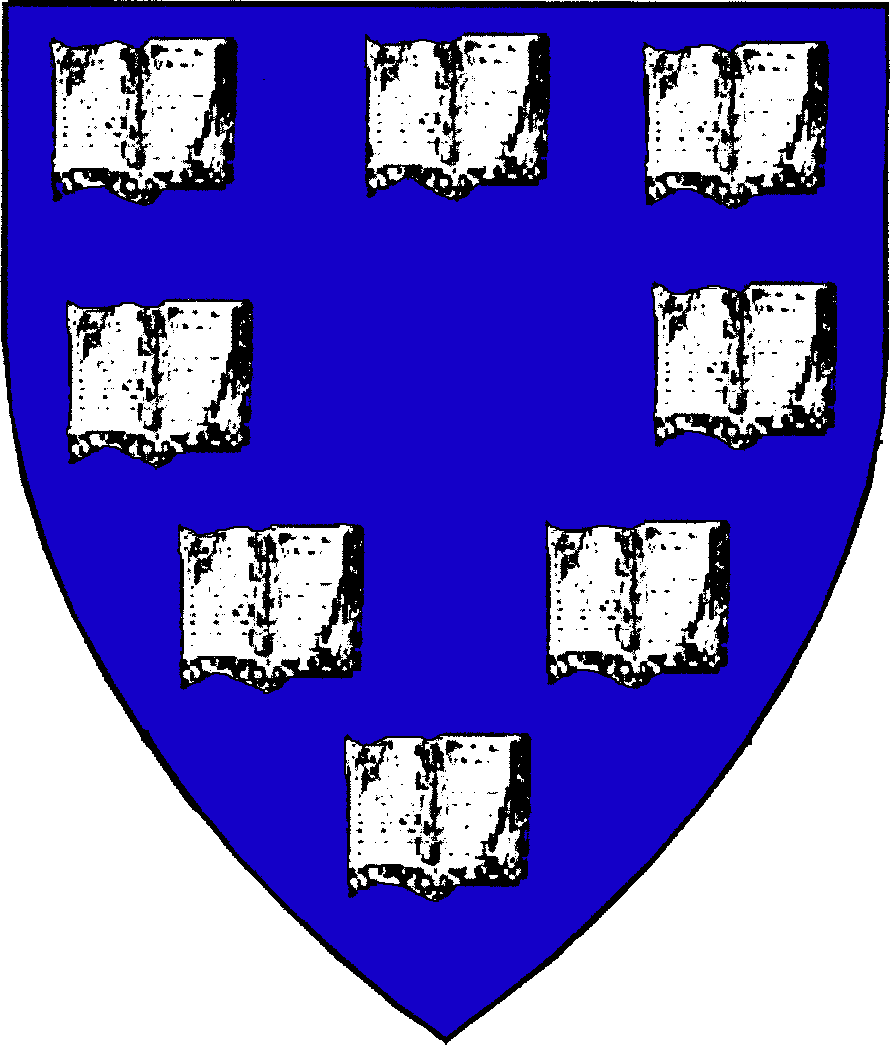
Device resubmission to Crux
Azure, eight open books in orle argent.
The submitter's name was submitted on the Lochac LoI dated April 20, 2002.
Her previous device submission of Azure, a griffin's head and in chief three open books argent was returned by me in April 2002 due to conflict. This redesign appears free of problems.
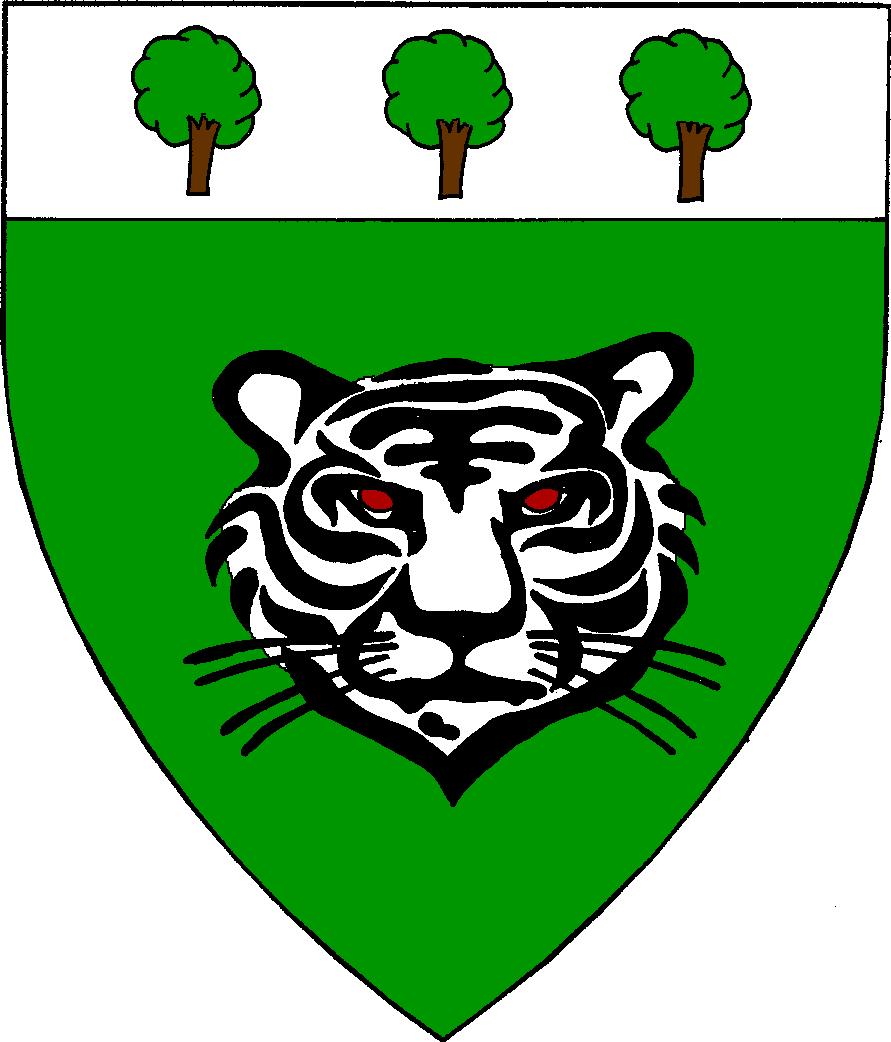
Device Resubmission to Laurel
Vert, a natural tiger's head caboshed argent marked sable, on a chief argent three trees proper.
The submitter's name was registered in June 1997. His previous device submission to Laurel, Per saltire vert and argent, a gurges counterchanged a bordure Or was returned in July 1997 for excessive counterchanging and unidentifiability.
This new design appears free of problems.
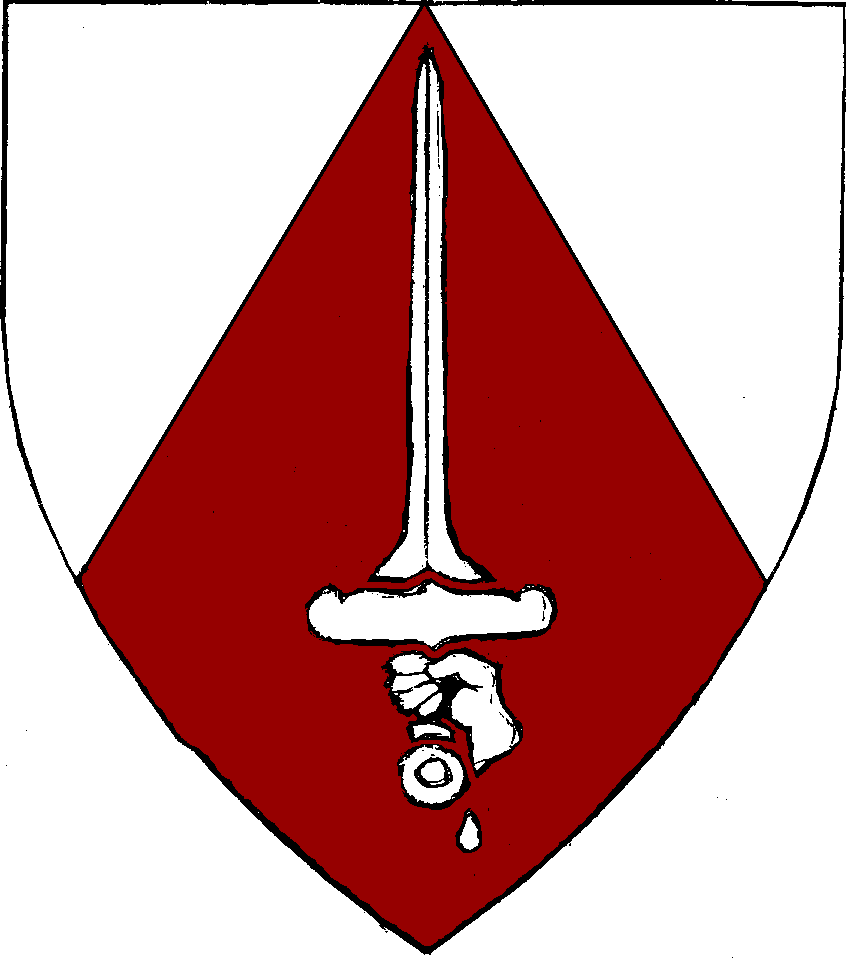
New Name and Device
Gules chapé argent, a sword maintained by a dexter hand argent.
The submitter desires a masculine 12th-14th century Anglo-Norman name, cares most about the language/culture and will accept major changes.
William: Reaney & Wilson (2nd ed., s.n. Williams, et al) date Henry Fitz William to 1300.
fitz Symon: Reaney & Wilson (ibid, s.n. Simon, et al) give Symon as a header spelling and date the name Symon de Cheurolcurt to circa 1150. They also list a William le fitz Simon from the reign of Henry II (1154-1189).
We believe that a visual check by Laurel will be required for the device against 'Azure, a sword proper, balanced on its point a pair of scales Or' [device for Conrad Tolbert Regnault, Feb 1980] and also 'Per pale azure and argent, a sword proper embrued' [device for Benson of Stannington, Dec 1975] to determine if the absence of the scales or 'embruing' are worth a second CD.
For those who are unfamiliar with the term, embrued means "bloody, or rather, dropping with blood...Weapons are thus blazoned...and also sometimes an animal, especially a wolf." (from Parker's Glossary). Strangely enough, the word is not listed in my Australian Concise Oxford Dictionary... more proof of society's continuing decline into illiteracy and ignorance! <sigh>
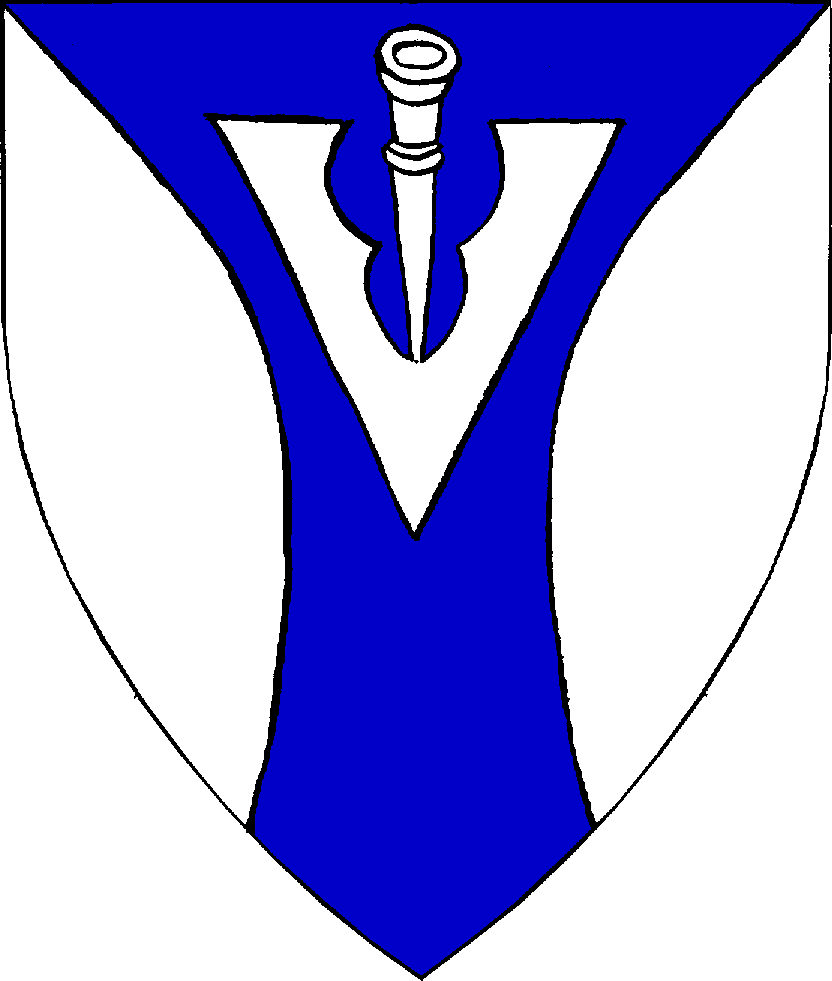
New Name and Device
Azure, in chief a pheon between flaunches argent.
The submitter desires a feminine name and will not accept any changes.
Ysabella: this is listed by Josh Mittleman (aka Arval Benicouer) in 'Feminine Given Names from Thirteenth Century Perugia'.
Vitale: Mittleman, in 'Fourteenth Century Venetian Personal Names' gives this as the Latin root form of the masculine given name Vitaliano. The list of surnames in the same article imply this could have been used as a patronymic, and a number of similar surnames (Garzone, Muxe, Natale, Paxe and Zane) are described as either patronymic or "possibly patronymic".
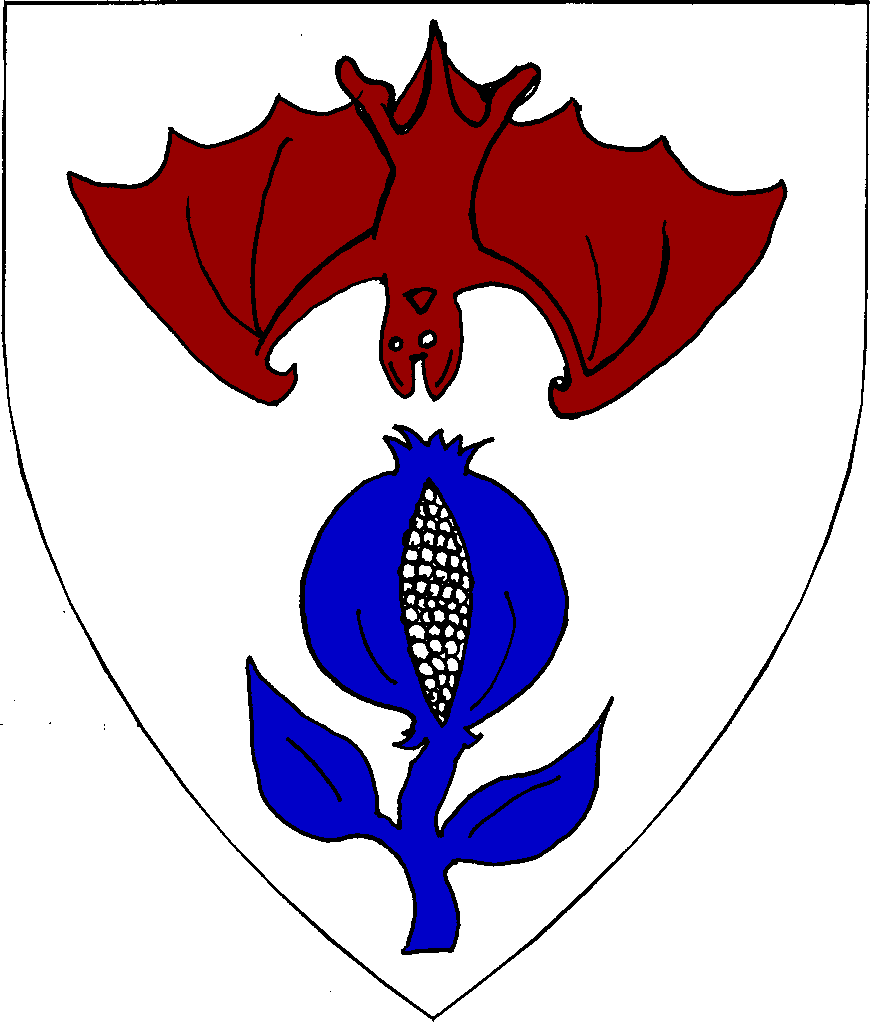
New Name and Device
Argent, in pale a reremouse inverted gules and a pomegranate azure.
The submitter desires a masculine 11th-12th Chinese Song Dynasty name and will accept minor changes only.
All elements are documented from the very detailed Academy of Saint Gabriel report #2346, written by Mei Li.
Zhou: this is the 'hsing', or family name.
Long Xi Xian Sheng: this is the personal name, which has an apparent literal meaning of 'River Dragon Teacher'. It is dated to 1079-1154.
The following submission was RETURNED for further work
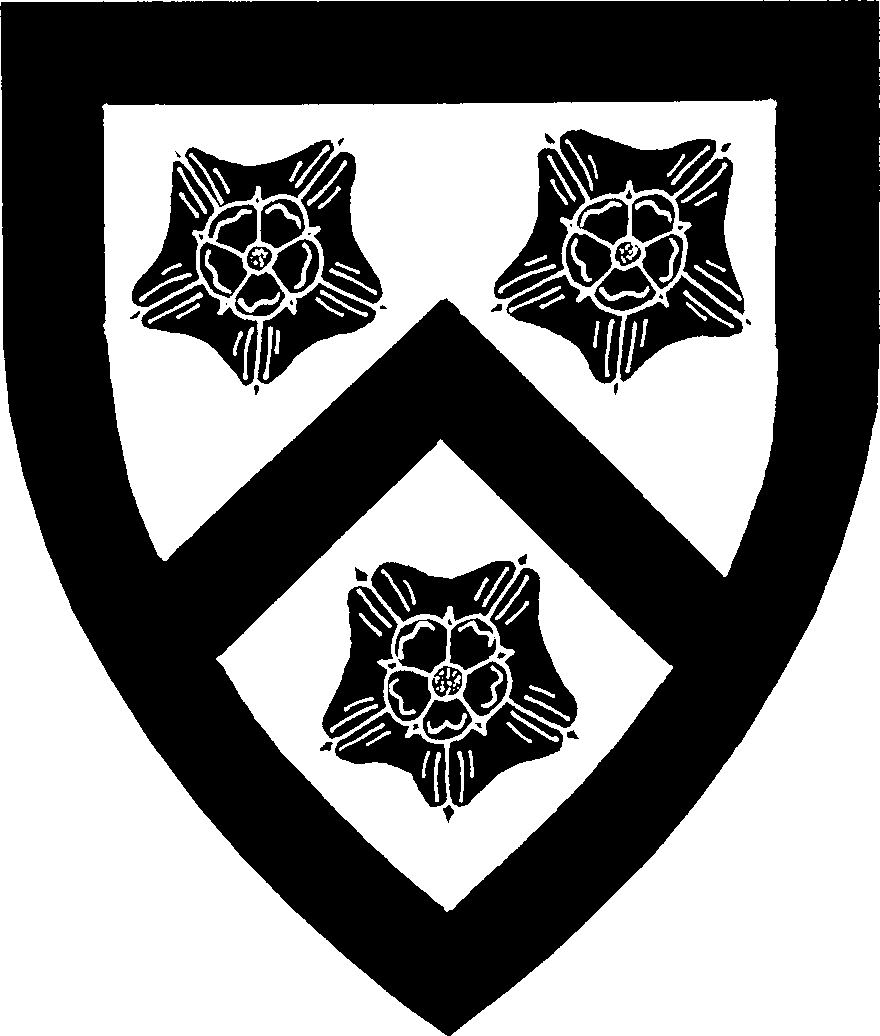
New Device
Argent, a chevron between three roses and a bordure sable.
This has been returned for redrawing. The 'roses' drawn here do not sufficiently resemble heraldic roses, nor any other common heraldic charge. Indeed, some people at the meeting mistook them for some kind of animal heads.
The odd thing is that the charges drawn resemble a five-sided object charged with perfectly good heraldic roses of the same tincture. Our guess is that the submitter has seen a particularly poor rendition of a double rose (one rose charged with another).
The following submission was PENDED
New Device
Vert,in pale a boar statant and a crescent argent.
This is pended until the submitter supplies an useable outline copy of the device for creating a mini-emblazon of it. Normally I would have been generous and made one myself, but illness and tight deadlines this month meant that wasn't possible. Besides, it is the submitter's responsibility (with the assistance of their consulting herald) to ensure all the paperwork is in order before a submission is sent to Crux for processing.
Lochac submissions from the March 2002 Letter of Acceptances and Returns (dated May 21, 2002):
REGISTEREDBordescros, Shire of. Branch name (see RETURNS for device)
Listed on the LoI as Borders Cross, Shire of, the name was originally submitted as Bordars Cross and changed at the principality level as no documentation could be found for Bordar.Catalina de Gata. NameThere was some discussion about whether or not this submission fit the model of an English placename. The LoI provided documentation for Borders Cross meaning 'cross used by boarders' or 'cross used by jesters'. However, neither of these meanings follow documented patterns for English placenames that include an element meaning 'cross'. The key point is that the modern usage of cross to mean 'crossroads' has not been found to be a period meaning. In English placenames, cross refers to a physical cross. So, the Horcros dated to 1230 in Ekwall (p. 243 s.n. Hoar Cross) meaning 'grey cross' that was cited in the LoI does not mean 'grey crossroads'. It refers to a physical cross that is grey. Similarly, the Staincros dated to the Domesday book in Ekwall (p. 435 s.n. Staincross) meaning 'stone cross' that was cited in the LoI does not mean 'stone crossroads'. Rather it refers to a cross made of stone. As both of these examples use the construction '[adjective] cross' where the adjective describes a physical attribute of the cross in question, the meanings 'cross used by boarders' and 'cross used by jesters' do not follow this pattern.
A second documented construction using 'cross' as the second element in an English placename has the meaning '[given name]'s cross'. As an example, Ekwall (p. 471 s.n. Thruscross) dates Thorecros to c. 1180 and Thorescros to c. 1210, and gives the meaning of this placename as '{TH}ori's cross'. Ekwall (p. 53 s.n. Bordesley) dates Bordeslegh to 1226-8 and gives the meaning of this placename as either 'Brodes l{e-}ah' or 'wood where boards were got'. Therefore, a hypothetical Bordescros would mean either 'Brodes cross' (which follows the pattern '[given name]'s cross' shown in Thorescross) or 'cross of boards' (which follows the pattern of an adjective describing the cross, as 'stone' does in Staincros).
As the submitting group allows any changes, we have changed the name to this form which follows documented period placename construction patterns and which sounds nearly identical to the Borders Cross listed on the LoI.
[Note from Crux: I must have done a particularly poor job with wording this one, as I had never intended to argue the element cross as meaning ‘crossroads’, as implied above, but always meant it to refer a physical cross. Still the name passed and the group are happy, so I won’t complain too much.]
Conan MacAindreis. Device. Gules, a sword between two ermine spots and on a chief argent a hanging balance gules.
Esteban de Quesada. Name.
Will Dekne. Argent, a phoenix and a chief wavy gules.
RETURNED
Bordescros, Shire of. Branch device. Per chevron purpure fretty Or and Or, in base a bunch of grapes purpure leaved within a laurel wreath vert.
This device uses three primary charges of three different types in a single charge group: the grapes, the wreath, and the fretty (which is equivalent to a fret). This is not allowable style by RfS VIII.1.a.[Note from Crux: I was warned by those at my submissions meeting that this would probably be returned for this very reason, but I argued that the rules imply some leeway in this, so it was worth a try. I now know that the ‘guideline’ of avoiding more than two types of charge in a group is rather more strictly enforced than the RfS imply! We live and learn...]
This CAMeL is the last that will ever be produced for the Principality of Lochac, and the last to be produced by me as Crux Australis (although I've promised Giles to web his for a while).
Reflecting on my time in office has led me to make a few observations.
First, the things that annoyed me the most whilst in the office were:
The things that I found most enjoyable were:
On the face of things it would appear that the annoyances outweighed the pleasures, but this was not the case (at least, not until recently). This job has been wonderfully rewarding, and I hope that Giles will find it so as well.
Nonetheless, his role is an onerous one, so please give him your full support during his term in this most diverse and challenging office. He shall certainly have mine.